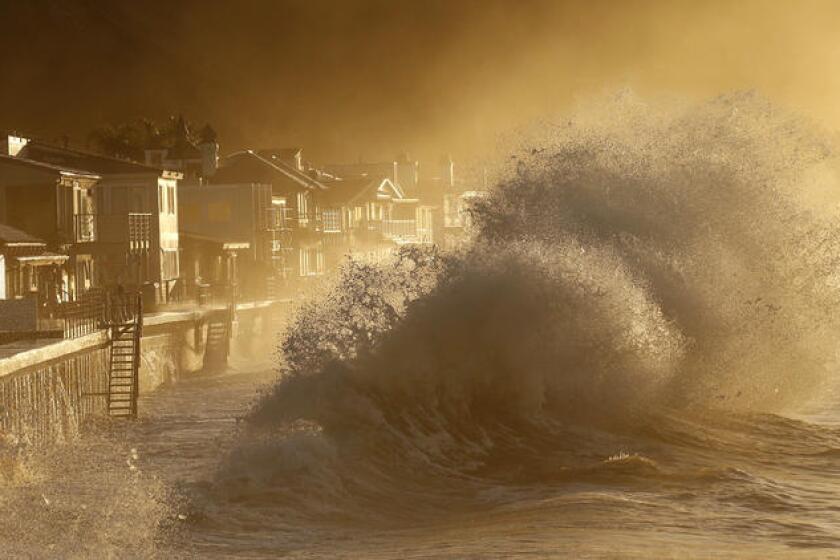An Earth Day message for California: Move faster on climate change
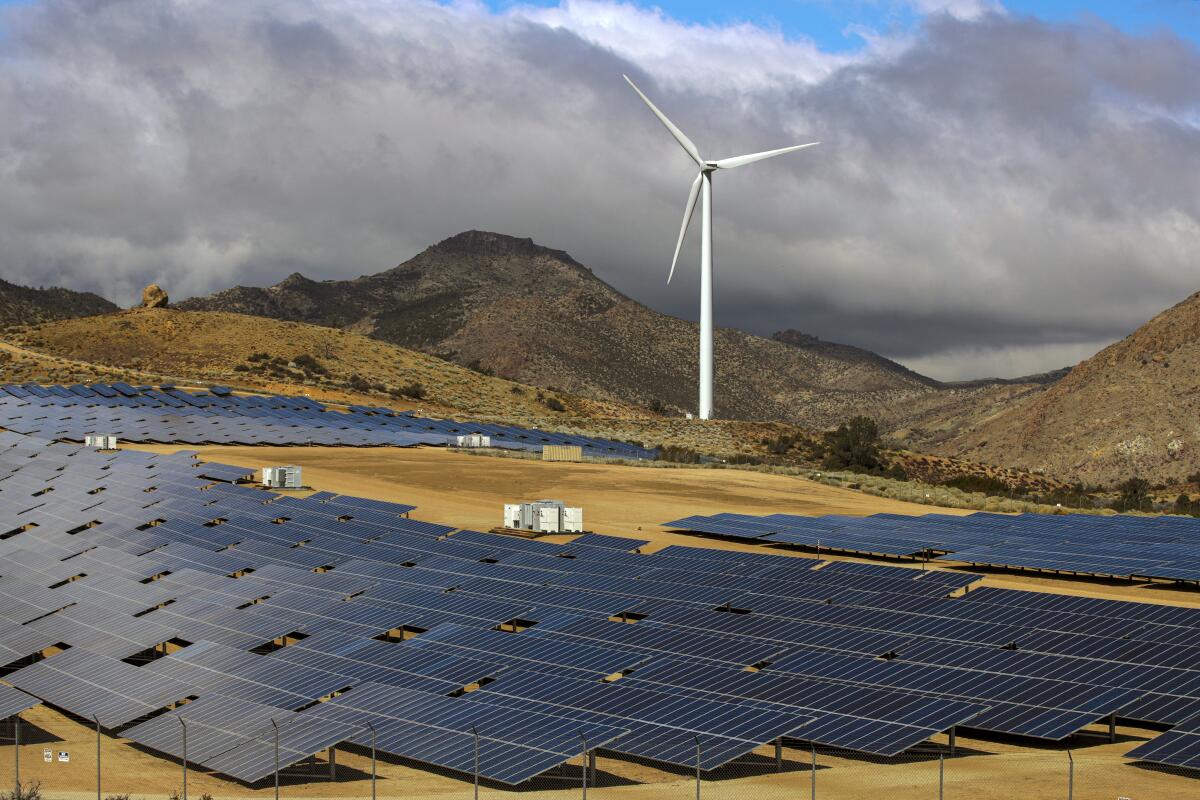
- Share via
If there’s one thing to understand this Earth Day about California’s role in confronting the climate crisis, it’s this: Just because the state considers itself a global leader doesn’t mean it’s doing nearly enough.
Gov. Gavin Newsom admitted as much last year. As monstrous wildfires carved a path of destruction from the giant sequoias of the Sierra Nevada to the mountains around Los Angeles — bringing smoke-choked orange skies to the Bay Area and raining ash to Southern California — Newsom said, “Across the entire spectrum, our goals are inadequate to the reality we’re experiencing.”
“We’re going to have to do more, and we’re going to have to fast-track our efforts,” Newsom told reporters as he stood among freshly charred trees in Oroville. “While it’s nice to have goals to get to 100% clean energy by 2045, that’s inadequate.”
Now, leading scientists are offering the governor a far more aggressive path forward.
That path is laid out in a not-yet-published paper from a team of researchers led by UC Berkeley’s Daniel Kammen, whose work for an international climate science panel helped it earn a Nobel Peace Prize. The researchers make the case that California must ratchet up its ambitions dramatically and immediately.
The scientists call for the state to reduce its planet-warming pollution nearly 80% by 2030, rather than the currently mandated 40%, through what they describe as a “a wartime-like mobilization of resources.”
Why should the Golden State double its efforts?
The paper rattles off a dizzying series of facts about the climate consequences already confronting Californians: 4.3 million acres burned in 2020, about 4% of the state; nearly $150 billion in health and economic damages from smaller firestorms two years earlier; and conflagrations so bad experts didn’t expect to see them for 30 more years. Not to mention worsening droughts, rising seas and hotter heat storms that are far deadlier than many people realize.
And despite the state’s long track record of leadership in phasing out fossil fuels, it’s now falling behind, the researchers say.
There’s no better sign of that than President Biden — once viewed with extreme skepticism by climate activists — trying to pass an infrastructure bill that sets a national goal of 100% clean electricity by 2035, a full decade ahead of California’s target.
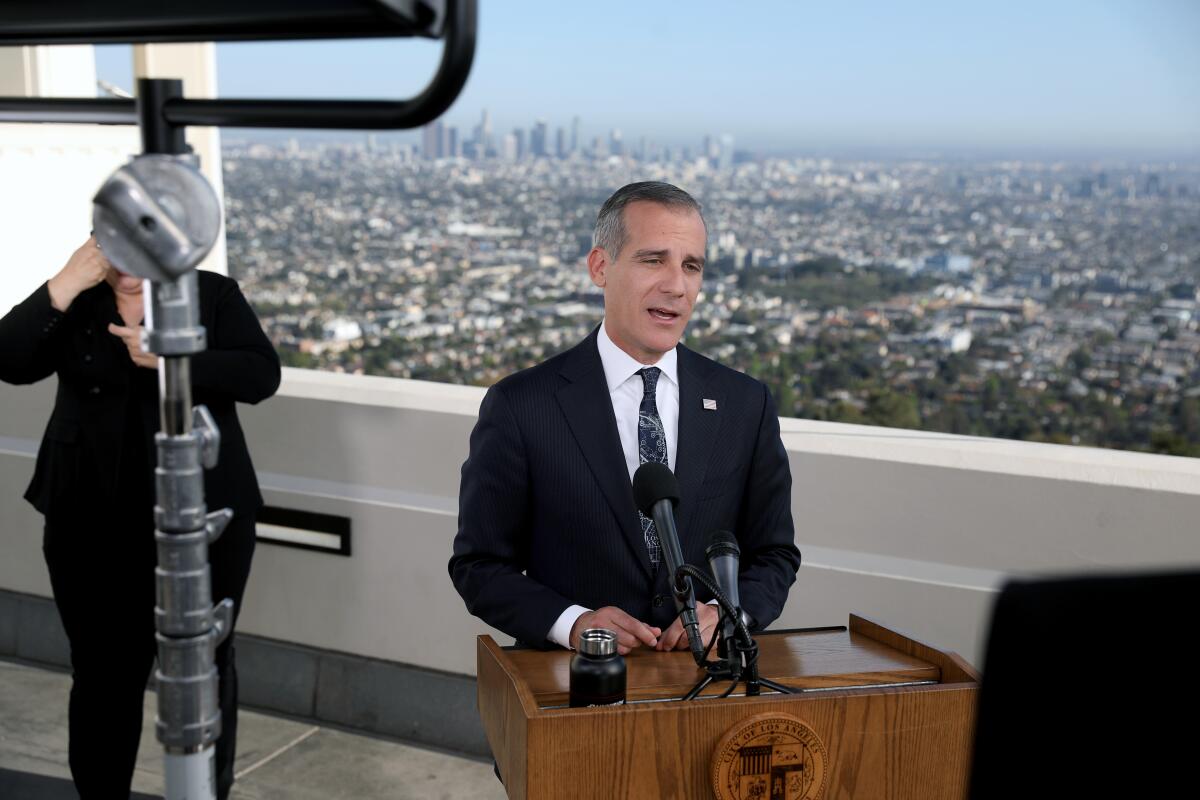
Los Angeles Mayor Eric Garcetti endorsed the same 2035 goal in his State of the City address Monday. That followed the release of a first-of-its-kind study by the federally funded National Renewable Energy Laboratory finding that L.A. can achieve 98% clean energy as early as 2030, and 100% by 2035, without increasing the risk of blackouts or disrupting the local economy.
Garcetti said in an interview that Newsom and the state Legislature should “absolutely” follow L.A.’s lead.
“This should encourage California to see that it’s achievable everywhere. If the biggest city in the state with the largest municipal utility in the country can do this, you can do it too,” Garcetti said.
“The reason why is obvious. This whole world, governments are missing their goals. Weather events are becoming more extreme, and the threat is greater today than it was yesterday,” he said.
There are examples overseas of governments picking up the pace.
The United Kingdom plans to ban the sale of gasoline-powered cars by 2030, half a decade ahead of Newsom’s deadline for California. British Prime Minister Boris Johnson recently set a target of slashing carbon emissions 68% by 2030, far more aggressive than California’s aim. Volvo says it will produce only electric vehicles by 2030. Finland is aiming for a carbon-neutral economy by 2035, 10 years ahead of California.
Lawmakers in Washington state also vaulted ahead of California last week, setting a goal to end the sale of gas-run cars by 2030.
“There’s a lot going on that we’re not taking advantage of,” Kammen said in an interview.
Toward a more sustainable California
Get Boiling Point, our newsletter exploring climate change, energy and the environment, and become part of the conversation — and the solution.
You may occasionally receive promotional content from the Los Angeles Times.
Kammen has previously served as a lead author for the United Nations-backed Intergovernmental Panel on Climate Change. His coauthors on the new paper include UC Merced cognitive scientist Teenie Matlock; USC sociologist Manuel Pastor; UC Santa Barbara sociologist David Pellow; UC San Diego climate scientist Veerabhadran Ramanathan; UC Santa Barbara political scientist Leah Stokes; and Tom Steyer, the billionaire climate activist who ran for the Democratic presidential nomination last year.
The group used a modeling tool developed by the Climate Center, a Santa Rosa-based nonprofit, to analyze how much the Golden State could cut emissions over the next nine years without causing energy costs to rise significantly. They determined a reduction of 77% below 1990 levels was feasible, largely because solar panels, wind turbines and batteries are getting so cheap.
“We didn’t work back from a target. We worked forward from what are the current price declines we’re seeing on the renewable and storage side,” Kammen said. “The 80% comes in at a sweet spot, where the prices don’t rise that much.”
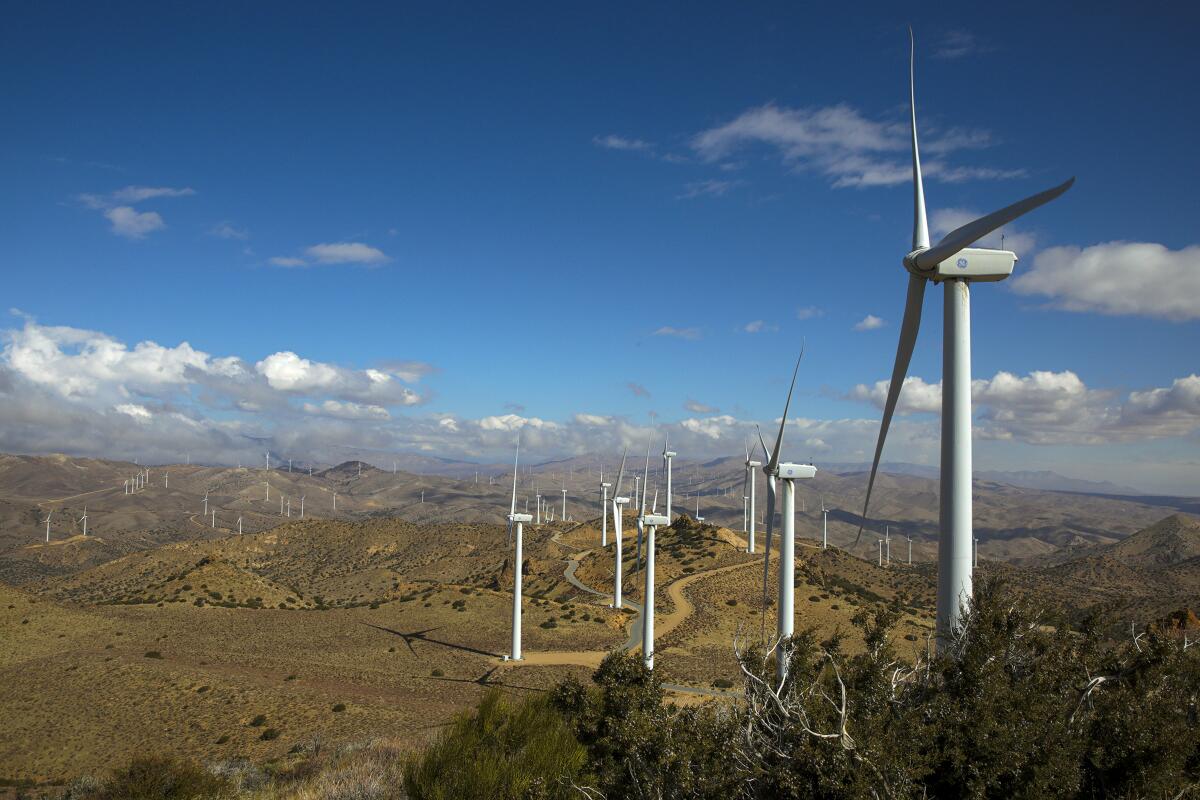
What would those changes look like in practice?
Under one pathway laid out in the paper, which is being reviewed by the journal Environmental Research Letters, California would need to reach 100% clean electricity by 2030. That would require building new infrastructure — including lots of offshore wind turbines — at a pace Kammen described as “a bit scary.” Emissions from transportation, the largest source of climate pollution, would need to fall 70% in nine years, almost certainly necessitating an end to the sale of gas cars sometime this decade.
“It’s really designed to be a wake-up call,” Kammen said.
There’s little question a wake-up call is needed.
The National Oceanic and Atmospheric Administration reported this month that concentrations of carbon dioxide and methane, the two most important greenhouse gases, reached record levels in 2020, rising rapidly despite a pandemic that slowed the global economy. The planet is already 1.2 degrees Celsius warmer than it was before the Industrial Revolution, nearing the 1.5 degrees that scientists have set as a target for staving off dangerous tipping points.
California plans to launch two climate-tracking satellites into orbit in 2023 to search for ‘super-emitters’ of planet-warming pollution.
The Intergovernmental Panel on Climate Change says limiting warming to 1.5 degrees would require slashing global emissions by 45% over the next decade. But the Kammen paper refers to that target as “inherently conservative,” and alludes to the reality that wealthy nations such as the United States are in a position to move more quickly than their poorer counterparts.
“States and nations with the ability to act must demonstrate through their actions that faster progress is possible,” the paper says.
Faster action to phase out fossil fuels would also result in cleaner air — especially in low-income neighborhoods and communities of color that have suffered the most from lung-damaging pollutants associated with the burning of coal, oil and natural gas.
New research highlighting the localized dangers of fossil fuel pollution emerges all the time.
A study published last week, written by doctors from USC’s Keck School of Medicine, tracked the health of Black and Latino residents of two South L.A. neighborhoods near oil and gas wells.
The researchers documented reduced lung function among people living closest to drilling sites, in some cases comparable to the harm from breathing secondhand smoke or living next to a freeway. They also found significantly more wheezing, sore throat and dizziness among people living near active wells, relative to idle wells.
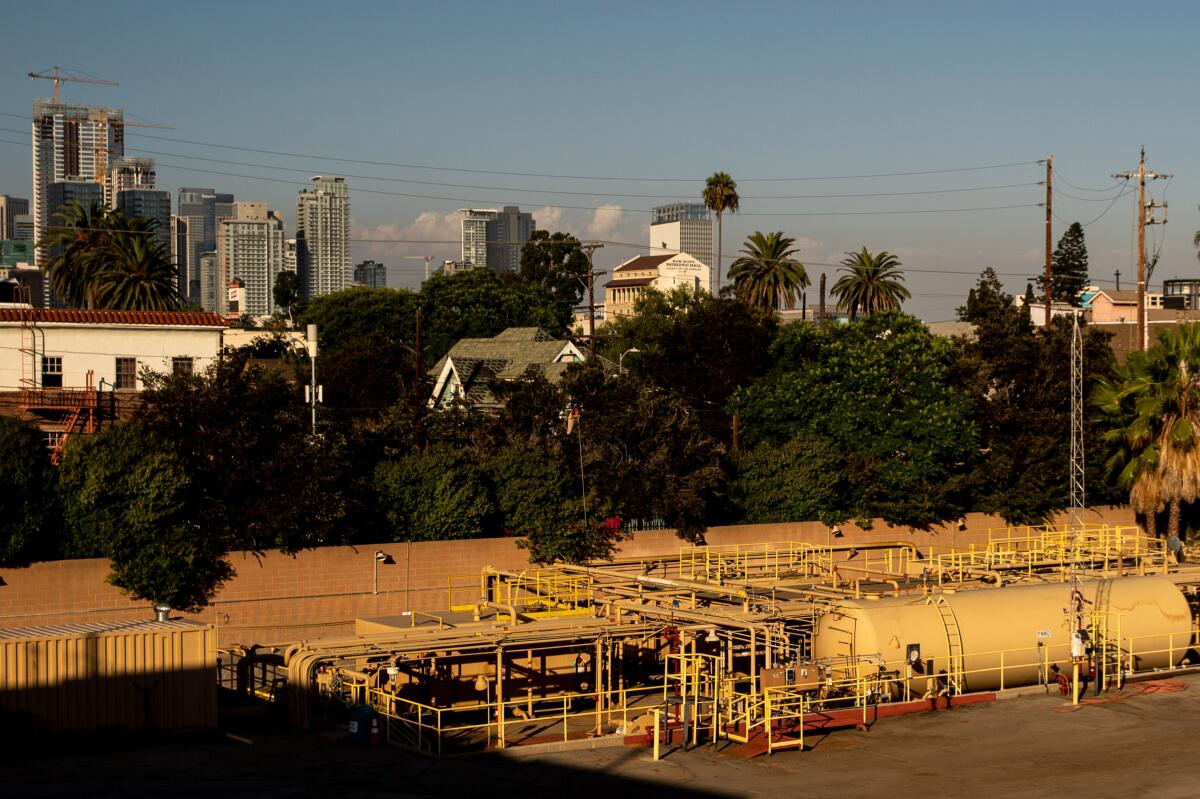
Also last week, a study from researchers at UCLA’s Fielding School of Public Health found that Los Angeles County neighborhoods with the worst air quality saw a 60% increase in COVID-19 deaths compared with neighborhoods with the cleanest air. That tracked with earlier research linking worse air pollution with greater susceptibility to the coronavirus, which attacks the lungs.
The most damaging air pollutants “tend to be higher in areas where there is some level of social disadvantage, whether that’s having a population like Black and Latinx people who are victims of racism and historical injustices like redlining, or whether it’s an economically disadvantaged population,” Michael Jerrett, the UCLA study’s lead author, told The Times last year.
If California were to slash carbon emissions nearly 80% by 2030, it would also see a three-quarters reduction in fine particulate matter, an air pollutant linked to heart disease and premature death, Kammen and his collaborators found.
Support our journalism
Your support helps us deliver the news that matters most. Subscribe to the Los Angeles Times.
It would certainly help for California to cut back on the oil and gas drilling technique known as fracking, Kammen said. That’s a key priority for climate activists, who have slammed Newsom’s administration for continuing to issue new fracking permits.
“The amount of fracking permits that have been issued is far higher than what makes sense,” Kammen said.
Newsom called on the Legislature to ban fracking last year. But a bill that would have done so failed in committee last week amid fierce opposition from the oil industry and labor unions, with clean-energy advocates saying Newsom did little to fight for it.
The governor’s inability or unwillingness to get the bill passed was only the latest in a string of frustrations for climate activists, who say Newsom and his appointees have failed to protect disadvantaged communities living near oil and gas wells by requiring buffer zones, and aren’t getting clean-energy installations built fast enough even to meet the state’s current climate goals.
Asked last week about fracking, Newsom said he’s still committed to banning the practice, and cited his order to phase out the sale of gasoline-powered cars as a major step to reduce the demand for oil. He also acknowledged he has got more to do on climate.
“We’re creative. We’re resourceful,” the governor said. “You’ll be hearing a lot more from me on this topic very, very shortly.”
Times staff writer Phil Willon contributed to this report.
More to Read
Your guide to our clean energy future
Get our Boiling Point newsletter for the latest on the power sector, water wars and more — and what they mean for California.
You may occasionally receive promotional content from the Los Angeles Times.
